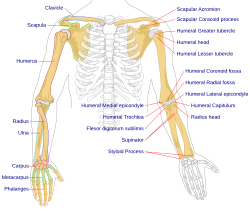The styloid process of the ulna is a bony prominence found at distal end of the ulna in the forearm.[1]
| Ulnar styloid process | |
|---|---|
 Bones of left forearm seen from front (ulnar styloid process labeled at bottom left) | |
 Diagram of bones in the human arm | |
| Details | |
| Identifiers | |
| Latin | processus styloideus ulnae |
| TA98 | A02.4.06.017 |
| TA2 | 1247 |
| FMA | 23628 |
| Anatomical terms of bone | |
Structure edit
The styloid process of the ulna projects from the medial and back part of the ulna. It descends a little lower than the head. The head is separated from the styloid process by a depression for the attachment of the apex of the triangular articular disk, and behind, by a shallow groove for the tendon of the extensor carpi ulnaris muscle.
The styloid process of the ulna varies from 2 to 6 mm in length.[1]
Function edit
The rounded end of the styloid process of the ulna connects to the ulnar collateral ligament of the wrist. The radioulnar ligaments also attaches to the base of the styloid process of the ulna.[2]
Clinical significance edit
Fractures of the styloid process of the ulna seldom require treatment when they occur in association with a distal radius fracture. The major exception is when the joint between these bones, the distal radioulnar joint (or DRUJ), is unstable. When the DRUJ is unstable, the ulnar styloid may require independent treatment.
An excessively long styloid process of the ulna can cause painful contact with the triquetral bone in the wrist, known as ulnar styloid impaction syndrome.[1] Radiology is used to diagnose it.[1] Conservative management involves injection of triamcinolone, while surgery involves shortening of the styloid process of the ulna via resection.[1]
The position of the styloid process of the ulna in relation to the wrist must be considered when applying a wrist splint.[3][4] This is important in preventing pressure ischaemia.[3]
References edit
This article incorporates text in the public domain from page 218 of the 20th edition of Gray's Anatomy (1918)
- ^ a b c d e Ombregt, Ludwig (2013-01-01), Ombregt, Ludwig (ed.), "23 - Disorders of the wrist", A System of Orthopaedic Medicine (Third Edition), Churchill Livingstone, pp. 333–349.e3, doi:10.1016/b978-0-7020-3145-8.00023-5, ISBN 978-0-7020-3145-8, retrieved 2020-12-12
- ^ Campbell, Douglas A. (2009-01-01), Slutsky, David J.; Osterman, A. Lee (eds.), "CHAPTER 28 - Ulnar Head and Styloid Fractures", Fractures and Injuries of the Distal Radius and Carpus, Philadelphia: W.B. Saunders, pp. 297–307, doi:10.1016/b978-1-4160-4083-5.00030-5, ISBN 978-1-4160-4083-5, retrieved 2020-12-12
- ^ a b Fess, Elaine Ewing; Gettle, Karan S.; Philips, Cynthia A.; Janson, J. Robin, eds. (2005-01-01), "CHAPTER 10 - Principles of Fit", Hand and Upper Extremity Splinting (Third Edition), Saint Louis: Mosby, pp. 252–277, doi:10.1016/b978-080167522-5.50015-0, ISBN 978-0-8016-7522-5, retrieved 2020-12-12
- ^ Fess, Elaine Ewing; Gettle, Karan S.; Philips, Cynthia A.; Janson, J. Robin, eds. (2005-01-01), "CHAPTER 20 - Analysis of Splints", Hand and Upper Extremity Splinting (Third Edition), Saint Louis: Mosby, pp. 539–574, doi:10.1016/b978-080167522-5.50025-3, ISBN 978-0-8016-7522-5, retrieved 2020-12-12
External links edit
- lesson4bonesofantforearm at The Anatomy Lesson by Wesley Norman (Georgetown University)